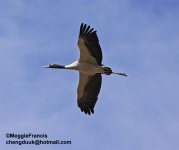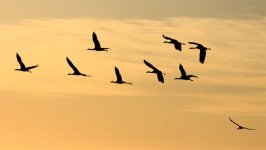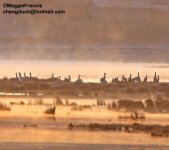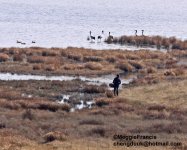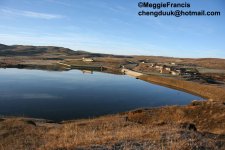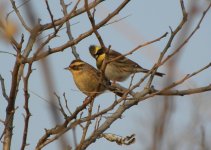-
Welcome to BirdForum, the internet's largest birding community with thousands of members from all over the world. The forums are dedicated to wild birds, birding, binoculars and equipment and all that goes with it.
Please register for an account to take part in the discussions in the forum, post your pictures in the gallery and more.
You are using an out of date browser. It may not display this or other websites correctly.
You should upgrade or use an alternative browser.
You should upgrade or use an alternative browser.
China observations (2 Viewers)
- Thread starter Gretchen
- Start date
More options
Who Replied?Part of my business has been the final process of getting a field guide for the area together. It's a picture guide to the common birds of Dalian and includes 185 species. Each species has 3 photos and a small written section describing identification, status in Dalian, and size. It's being done by Green Grants and NGO organization all over China. Translation is finished and now we are working on layout, printers, etc...
Sounds like a significant project! You're saying it'll be bilingual? Who's publishing/printing? Would love to hear more about what kinds of cooperation there's been by local birders and organizations some time (when you have time). Great work!
Gretchen
Mike, have you had any Chinese(Swinhoe's) Egrets in Hong Kong yet? I know you posted earlier on another thread about them wintering by you? passing through? I have taken interest in them b/c they are one of the few birds in my area that are not seen in many other places regularly and b/c they are endangered. Where do they winter?
What about Black-faced Spoonbills? I saw on "Wild China" by BBC that they winter around Hong Kong. Have you seen any yet? They nest about an hour from my house but right now I think they would be frozen to death. The rest nest on islands between here and Korea.
Funny that earlier people were talking about how unusually warm of a fall was being experienced. The weather now is the coldest its ever been in November in the six years I've lived here. Wierd.
I'm going to Jilin on a hockey trip next weekend. Jilin is a city and a province in the north and should produce some good birding.(If i have time)
Tom
What about Black-faced Spoonbills? I saw on "Wild China" by BBC that they winter around Hong Kong. Have you seen any yet? They nest about an hour from my house but right now I think they would be frozen to death. The rest nest on islands between here and Korea.
Funny that earlier people were talking about how unusually warm of a fall was being experienced. The weather now is the coldest its ever been in November in the six years I've lived here. Wierd.
I'm going to Jilin on a hockey trip next weekend. Jilin is a city and a province in the north and should produce some good birding.(If i have time)
Tom
china guy
A taff living in Sichuan
We're also experiencing cold - but in a province you normally expect heat - Yunnan. Mind you that was at 3000m on a grassland, in the north, watching the Black-necked Cranes arrive at their wintering grounds - but at times it was a chilly experience.
We'll get home, to the Chengdu area, late tonight - but unlike our brethren in the north - no central heating in Sichuan - the great helmsman thought it unnecessary for the heating of homes south of the Yangtze. But we've kitted our apartment with a little extra insulation and oil filled electric radiators - rather than take on the local tradition of wearing 10 layers of clothing, hat and gloves, while watching TV in a cold winter's living room.
With the general lack of heating - living in winter Chengdu - where there are never minus temps - can sometimes feel colder than living up in the icy north!!!!!!!!!!!!!!!!!!!!!!!!!
We'll get home, to the Chengdu area, late tonight - but unlike our brethren in the north - no central heating in Sichuan - the great helmsman thought it unnecessary for the heating of homes south of the Yangtze. But we've kitted our apartment with a little extra insulation and oil filled electric radiators - rather than take on the local tradition of wearing 10 layers of clothing, hat and gloves, while watching TV in a cold winter's living room.
With the general lack of heating - living in winter Chengdu - where there are never minus temps - can sometimes feel colder than living up in the icy north!!!!!!!!!!!!!!!!!!!!!!!!!
Last edited:
MKinHK
Mike Kilburn

Hi Tom
BF Spoonbills are in - I saw over 100 on Sunday and we've have around 300-400 wintering in recent years.
Swinhoe's Egret winter around the S China Sea and south but do not go through HK in autumn.
Jilin in winter sounds VERY cold. I guess you may have an outside chance of Snowy Owl or Blakiston's fish which has been recorded, but I'm not sure where.
I'd also be really interested to hear if there are any auks on the sea around the Liaoning Peninsula in winter.
Cheers
Mike
BF Spoonbills are in - I saw over 100 on Sunday and we've have around 300-400 wintering in recent years.
Swinhoe's Egret winter around the S China Sea and south but do not go through HK in autumn.
Jilin in winter sounds VERY cold. I guess you may have an outside chance of Snowy Owl or Blakiston's fish which has been recorded, but I'm not sure where.
I'd also be really interested to hear if there are any auks on the sea around the Liaoning Peninsula in winter.
Cheers
Mike
china guy
A taff living in Sichuan
Here's some pics from our chilly Crane watching at the Dashanbao Nature Reserve in Northern Yunnan - well it wasn't so cold during the midday when the sun was shining - but those frosty mornings and clear-sky evenings made an ear-lobe or two tingle!!!!!
Thankfully after gloomy posts of hunting that have recently peculated through the China threads - we can happily report on a conservation story from this reserve - one which leads towards protection and a local population realizing that live birds can be a potential money earner. All this has come about because a local lady, Chen Guanghui - has taken on the task of feeding wintering Black-necked Cranes. And even though the practice of feeding wild bird populations can be a questionable one - with issues involving possible habituation to human contact - it seems that any activity that's proactive in maintaining population numbers of any bird is far preferable to the usual gauntlet of net and gun that many migrants suffer during their passage through China. Indeed winter populations of the rare Cranes at this reserve have built up in number and have exceeded the 1000 mark.
On top of the feeding - Chen Guanghui - has started to build up a little eco-industry on the backs of the birds - with a guesthouse that's built just over the road from a complex of viewing hides - which are the very first we've ever seen in China.
This place is a very long day's ride from Chengdu (well at least if there's not a landslide on the motorway - as on our trip - which which meant 2 day's driving). We did it in combo with the Sichuan Hill Partridge site - Laojunshan - which is situated just on the Sichuan/Yunnan border.
The place, which is located around the 3,000m mark, is a photographer's dream land - that is if the sun is shining. On our last day we woke up in the clouds and could barely see a hand in front of our noses.
Other birds are waterfowl and raptors - but nothing too spectacular - still early on in season for many ducks. There was also a single Common Crane present.
Pics are of Cranes - the Crane Lady - and her Crane Empire complete with hides and guesthouse.
Thankfully after gloomy posts of hunting that have recently peculated through the China threads - we can happily report on a conservation story from this reserve - one which leads towards protection and a local population realizing that live birds can be a potential money earner. All this has come about because a local lady, Chen Guanghui - has taken on the task of feeding wintering Black-necked Cranes. And even though the practice of feeding wild bird populations can be a questionable one - with issues involving possible habituation to human contact - it seems that any activity that's proactive in maintaining population numbers of any bird is far preferable to the usual gauntlet of net and gun that many migrants suffer during their passage through China. Indeed winter populations of the rare Cranes at this reserve have built up in number and have exceeded the 1000 mark.
On top of the feeding - Chen Guanghui - has started to build up a little eco-industry on the backs of the birds - with a guesthouse that's built just over the road from a complex of viewing hides - which are the very first we've ever seen in China.
This place is a very long day's ride from Chengdu (well at least if there's not a landslide on the motorway - as on our trip - which which meant 2 day's driving). We did it in combo with the Sichuan Hill Partridge site - Laojunshan - which is situated just on the Sichuan/Yunnan border.
The place, which is located around the 3,000m mark, is a photographer's dream land - that is if the sun is shining. On our last day we woke up in the clouds and could barely see a hand in front of our noses.
Other birds are waterfowl and raptors - but nothing too spectacular - still early on in season for many ducks. There was also a single Common Crane present.
Pics are of Cranes - the Crane Lady - and her Crane Empire complete with hides and guesthouse.
Attachments
Sid, great to hear about and see pics of your crane watching! It was surely cheery news. What does someone feed cranes by the way?
Went out for a chilly but sunny afternoon (3-5 pm), probably around 0 Celsius, but blessedly little wind. Didn't see any cranes, as I had hoped to, and not too much else either. But there was a late curlew and a green sand (I think, a little distant) - the latter seemed "frozen in place", hopefully not literally but he didn't seem to move. Wonder how late he is? Hopefully he knows where to head south.
Most interesting birds were buntings in the grasses on the sandflats. There were maybe 4-6 up high near the seed heads eating, but even so were quite tricky to see with the movement of the grasses. I mostly saw some almost blindingly white breast (well, in the low angle sunlight), and white malar stripes (maybe black beneath the beak? maybe black on head?). With the few glimpses I got, there are still a lot of bunting possibilites, but I have two questions, don't know if anyone has thoughts on:
1) Are buntings other than Pallas' Reed and Common Reed likely to be up in the marsh grass like that?
2) Do buntings hang out in mixed groups? (I'm really not sure all the ones I saw were the same.)
Oh and one related question, do other birds (buntings?) hang out with tree sparrows? I mean if I identify one in a group as tree sparrow, can I be sure they all are? (I didn't see a tree sparrow in that bunting group, but saw some elsewhere in the marsh.)
One other mystery. I thought I saw a large brown winged bird flying away from me low over the marsh. I thought it could be a hawk or owl, but I don't think it landed in a tree (seemed to disappear behind the grasses), and didn't reappear. I don't know if that brings to mind any possibilities or if the id is wide open.
Little egret flock was down to 6 brave (hopefully not foolish) birds fluffed up and looking cold. A few little grebes still around. A lot of ponds were frozen over and I saw only distant views of a half dozen ducks.
PS Also meant to ask - do buntings go into non-breeding plumage before or after migration? (Or perhaps it depends on the species?)
Went out for a chilly but sunny afternoon (3-5 pm), probably around 0 Celsius, but blessedly little wind. Didn't see any cranes, as I had hoped to, and not too much else either. But there was a late curlew and a green sand (I think, a little distant) - the latter seemed "frozen in place", hopefully not literally but he didn't seem to move. Wonder how late he is? Hopefully he knows where to head south.
Most interesting birds were buntings in the grasses on the sandflats. There were maybe 4-6 up high near the seed heads eating, but even so were quite tricky to see with the movement of the grasses. I mostly saw some almost blindingly white breast (well, in the low angle sunlight), and white malar stripes (maybe black beneath the beak? maybe black on head?). With the few glimpses I got, there are still a lot of bunting possibilites, but I have two questions, don't know if anyone has thoughts on:
1) Are buntings other than Pallas' Reed and Common Reed likely to be up in the marsh grass like that?
2) Do buntings hang out in mixed groups? (I'm really not sure all the ones I saw were the same.)
Oh and one related question, do other birds (buntings?) hang out with tree sparrows? I mean if I identify one in a group as tree sparrow, can I be sure they all are? (I didn't see a tree sparrow in that bunting group, but saw some elsewhere in the marsh.)
One other mystery. I thought I saw a large brown winged bird flying away from me low over the marsh. I thought it could be a hawk or owl, but I don't think it landed in a tree (seemed to disappear behind the grasses), and didn't reappear. I don't know if that brings to mind any possibilities or if the id is wide open.
Little egret flock was down to 6 brave (hopefully not foolish) birds fluffed up and looking cold. A few little grebes still around. A lot of ponds were frozen over and I saw only distant views of a half dozen ducks.
PS Also meant to ask - do buntings go into non-breeding plumage before or after migration? (Or perhaps it depends on the species?)
Last edited:
china guy
A taff living in Sichuan
When encountering a hungry Crane - a pocket full of corn or chopped potatoes may help you make a new bird-friend!!!!!!What does someone feed cranes by the way?
Last edited:
rockfowl
Mark Andrews
Sid, great to hear about and see pics of your crane watching! It was surely cheery news. What does someone feed cranes by the way?
Went out for a chilly but sunny afternoon (3-5 pm), probably around 0 Celsius, but blessedly little wind. Didn't see any cranes, as I had hoped to, and not too much else either. But there was a late curlew and a green sand (I think, a little distant) - the latter seemed "frozen in place", hopefully not literally but he didn't seem to move. Wonder how late he is? Hopefully he knows where to head south.
Most interesting birds were buntings in the grasses on the sandflats. There were maybe 4-6 up high near the seed heads eating, but even so were quite tricky to see with the movement of the grasses. I mostly saw some almost blindingly white breast (well, in the low angle sunlight), and white malar stripes (maybe black beneath the beak? maybe black on head?). With the few glimpses I got, there are still a lot of bunting possibilites, but I have two questions, don't know if anyone has thoughts on:
1) Are buntings other than Pallas' Reed and Common Reed likely to be up in the marsh grass like that?
Yes, mostly Pallas's and Japanese Reed, Common Reed is the species least encountered
2) Do buntings hang out in mixed groups? (I'm really not sure all the ones I saw were the same.)
Yes
Oh and one related question, do other birds (buntings?) hang out with tree sparrows? I mean if I identify one in a group as tree sparrow, can I be sure they all are? (I didn't see a tree sparrow in that bunting group, but saw some elsewhere in the marsh.)
Yes they do form mixed feeding flocks, often with Rustic, Little and Yellow-throated, especially in areas like the reservoir edge
One other mystery. I thought I saw a large brown winged bird flying away from me low over the marsh. I thought it could be a hawk or owl, but I don't think it landed in a tree (seemed to disappear behind the grasses), and didn't reappear. I don't know if that brings to mind any possibilities or if the id is wide open.
Probably a Short-eared Owl, a good area for them and the right time of year!
Little egret flock was down to 6 brave (hopefully not foolish) birds fluffed up and looking cold. A few little grebes still around. A lot of ponds were frozen over and I saw only distant views of a half dozen ducks.
PS Also meant to ask - do buntings go into non-breeding plumage before or after migration? (Or perhaps it depends on the species?)
Both, not necessarily species dependant
If this makes sense
No auks here in the winter. I think it must be the shallow sea or the lack of fish in the area. I haven't seen any loons/divers in the area also which has always surprised me a little. There are plenty of Mergansers, Goldeneye, Grebes, and other diving ducks who do find something to eat here through the winter. It could also be just here in my area and I don't have other people here to swap info or share observations with. I rarely get out the other areas of the ocean here on the peninsula.
I did get out birding yesterday for about an hour in one of my favorite areas but was turned back by the cold after a while. I managed a nice photo of Elegant/Yellow-throated Bunting and Siberian Accentor side by side showing how the two could be confused in a quick glance.
Bird list from yesterday:
Ring-necked Pheasant
Japanese Quail
Little Grebe
Upland Buzzard
Azure-winged Magpie
Black-billed Magpie
Eastern Great Tit
Chinese Bulbul
Vinous-throated Parrotbill
Naumann's Thrush
Dusky Thrush
Daurian Redstart
Eurasian Tree Sparrow
Siberian Accentor
Brambling
Oriental Greenfinch
Meadow Bunting
Rustic Bunting
Elegant Bunting
Common Reed Bunting
Tom
I did get out birding yesterday for about an hour in one of my favorite areas but was turned back by the cold after a while. I managed a nice photo of Elegant/Yellow-throated Bunting and Siberian Accentor side by side showing how the two could be confused in a quick glance.
Bird list from yesterday:
Ring-necked Pheasant
Japanese Quail
Little Grebe
Upland Buzzard
Azure-winged Magpie
Black-billed Magpie
Eastern Great Tit
Chinese Bulbul
Vinous-throated Parrotbill
Naumann's Thrush
Dusky Thrush
Daurian Redstart
Eurasian Tree Sparrow
Siberian Accentor
Brambling
Oriental Greenfinch
Meadow Bunting
Rustic Bunting
Elegant Bunting
Common Reed Bunting
Tom
Attachments
xiaoming
Well-known member
No auks here in the winter. I think it must be the shallow sea or the lack of fish in the area. I haven't seen any loons/divers in the area also which has always surprised me a little. Tom
Hi tom,
If you are interested in Loons, Murrelets and Sea Cormorants......., I suggest you vist Shichengliedao islands, not far from dalian.
Li Ming
If this makes sense
Mark, yes - quite clear. Just wish we could get those buntings to be a bit more organized about molting - it gives me about double the number of possible plumages to consider. Nice to think the other might have been SEO - maybe a better view next time.
Sid, glad you don't have to keep a pocket full of invertebrates to make friends with cranes (really I guess I had no idea what they ate :eek!
Tom, fascinating picture and good sightings considering the cold. Especially impressed about the quail - they're not easy to see, are they?
Xiaoming, I was on those islands last June as part of a WWF Black-faced Spoonbill count. It's an amazing place! Saw Pelagic Cormorant there but I would imagine there is more ocean birds there now in the winter.
Gretchen, Japanese Quail are the little guys that fly up after you nearly step on them in short grass.
Gretchen, Japanese Quail are the little guys that fly up after you nearly step on them in short grass.
mcaribou
Migration coming
Thanks Xiaoming
which species occur?
Mike
usually Pelagic and Japanese Cormorant,White-winged Scoter,Black-throated Loon,Long-tailed Duck.
U can contact Bai Qingquan in Dandong for more info.I guess he also joined in WWF's BFS trip this spring.
Hope to see Pacific Loon if I'm free to do a seawatch in Lianyungang this winter,and maybe Yellow-billed again.
Users who are viewing this thread
Total: 3 (members: 0, guests: 3)




